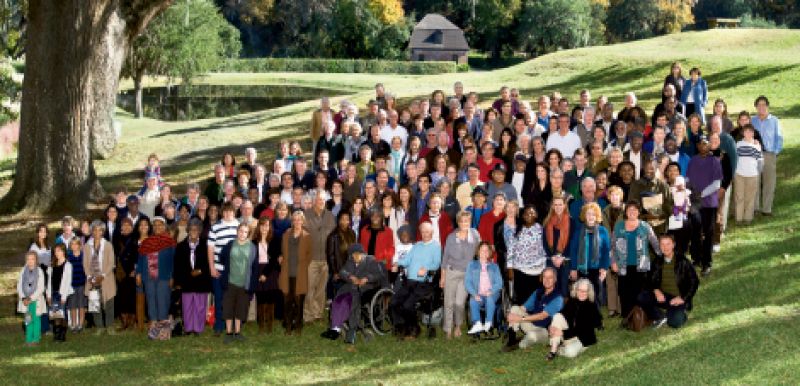
Even mediocre history students know the names—they trip off the tongue, part of the common Lowcountry lexicon: Edward Middleton, the British patriarch; Henry, his son; Arthur; Henry again. We know the impressive achievements of these four generations: president of the Continental Congress, signer of the Declaration of Independence, governor of South Carolina, minister to Russia. And we know, too, the other pedigreed Charleston surnames that repeatedly intertwine, like rampant wisteria, on the Middleton family tree: Izard, Williams, Pringle, Rutledge.
But we are less familiar with a whole other litany, a beautiful ancient poetry of now-forgotten names: Mingo, Quamino, Sansabe, Sipio, Willoughby. There’s Mercury, Tumma, Hagar, Toola, Quash, and Cudgoe…. These, too, are Middleton names, though their positions were not governor or president: Stephen, carpenter; Kouli-Kan, cooper; Hercules, house servant; Mary, house wench and pastry cook; Abram, cook; Quaco, blacksmith.
Genealogy is serious business in Charleston, especially if you happen to hail from a founding family whose political and cultural influence on the Lowcountry, the state, and indeed on our nascent nation was nothing short of momentous. For decades, the widely dispersed descendants of Henry and Arthur’s clan have gathered periodically on the grounds of Middleton Place. The reunions have been opportunities to celebrate and explore their heritage, to meet distant cousins and share family tales as they stroll the gardens’ paths. To admire prized camellias (also direct descendants of Henry’s legacy) and perhaps peer into their past while they gaze into the renowned butterfly lakes, as did their ancestors centuries ago. But until the 2006 Middleton reunion, the images that reflected back from those famously symmetrical lakes were noticeably asymmetrical. They were only the faces of the European-American descendants. Just one side of the Middleton story.
This past November marked the second combined gathering of the broader Middleton family—those whose ancestors owned the family’s 19 plantations and those whose forebears were owned by them. The first such reunion in 2006 drew some 300 European-American and African-American descendants to a weekend program entitled “A Place to Begin.” Both reunion weekends included research presentations, history lectures, informal dialogues, and a dinner—2011’s keynoted by author Pat Conroy. “That first time was intense. People shared things they’d been thinking about but had never been able to say,” says Ken Middleton of Orangeburg, whose late father, Earl, a Middleton Place Foundation trustee, proposed the combined gathering. “The dialogue brought out hundreds of years of deep, deep emotion. I think there was important reconciliation.”
The reunions, however, are more than an emotional delving into once-brushed-aside family secrets; they play a central role in furthering the mission of Middleton Place Foundation, a nonprofit educational trust that owns and runs the plantation, stableyard, and house museum and aims “to achieve the highest levels of historic preservation and interpretation.” Returning progeny often also return family documents, letters, and artifacts, adding them to the foundation’s collection, such as in 2009 when Eleanor Phillips Brackbill from New York loaned two 18th-century silver candlesticks that had been in her family, both engraved with the Middleton coat of arms and the initials “A.M.”, thus finally completing the stately set of eight that Arthur purchased in London in 1771. Yet even when the contributions are less tangible—when they are merely lore and memory, when they are tears or laughter, shame or pride offered up in an afternoon open-floor reunion “dialogue”—they are no less valuable.
“Telling the whole story is vitally important. It’s not enough to tell just the history of white people in the big house. By bringing everyone together, we are sharing history, and when we share history, we’re contributing to it,” says Charles Duell, a direct descendant and president of the foundation. “We’re building a more complete and humanly integrated story.”
And so the research continues as plans for the next combined reunion in 2016 begin to formulate. Tracing the genealogical trail of the African-American descendants is much more difficult than for the white Middletons, as the footprints one typically follows—last names, birth or marriage certificates, and property deeds—rarely exist. The foundation’s database currently includes 850 descendants, plus spouses and children, and November’s reunion drew 200 of them, the majority from outside the state. The hope is that connections will deepen and the Middleton story will become fuller and richer, because as Duell notes, the family’s history is truly American history. “[History] is an important part of the human psyche as we move forward through generations,” he adds. “A sense of place and a sense of history are grounding and form the infrastructure of our American lives. We are all vitally linked together.”